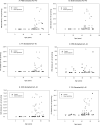Association between frontal cortex oxidative damage and beta-amyloid as a function of age in Down syndrome
- PMID: 22009041
- PMCID: PMC3260028
- DOI: 10.1016/j.bbadis.2011.10.001
Association between frontal cortex oxidative damage and beta-amyloid as a function of age in Down syndrome
Abstract
Down syndrome (DS) is the most common genetic cause of intellectual disability in children, and the number of adults with DS reaching old age is increasing. By the age of 40 years, virtually all people with DS have sufficient neuropathology for a postmortem diagnosis of Alzheimer disease (AD). Trisomy 21 in DS leads to an overexpression of many proteins, of which at least two are involved in oxidative stress and AD: superoxide dismutase 1 (SOD1) and amyloid precursor protein (APP). In this study, we tested the hypothesis that DS brains with neuropathological hallmarks of AD have more oxidative and nitrosative stress than those with DS but without significant AD pathology, as compared with similarly aged-matched non-DS controls. The frontal cortex was examined in 70 autopsy cases (n=29 control and n=41 DS). By ELISA, we quantified soluble and insoluble Aβ40 and Aβ42, as well as oligomers. Oxidative and nitrosative stress levels (protein carbonyls, 4-hydroxy-2-trans-nonenal (HNE)-bound proteins, and 3-nitrotyrosine) were measured by slot-blot. We found that soluble and insoluble amyloid beta peptide (Aβ) and oligomers increase as a function of age in DS frontal cortex. Of the oxidative stress markers, HNE-bound proteins were increased overall in DS. Protein carbonyls were correlated with Aβ40 levels. These results suggest that oxidative damage, but not nitrosative stress, may contribute to the onset and progression of AD pathogenesis in DS. Conceivably, treatment with antioxidants may provide a point of intervention to slow pathological alterations in DS.
Copyright © 2011 Elsevier B.V. All rights reserved.
Figures




References
-
- Aksenov MY, Aksenova MV, Markesbery WR, Butterfield DA. Amyloid beta-peptide (1-40)-mediated oxidative stress in cultured hippocampal neurons. Protein carbonyl formation, CK BB expression, and the level of Cu, Zn, and Mn SOD mRNA. Journal of molecular neuroscience : MN. 1998;10:181–192. - PubMed
-
- Aksenov MY, Aksenova MV, Butterfield DA, Geddes JW, Markesbery WR. Protein oxidation in the brain in Alzheimer's disease. Neuroscience. 2001;103:373–383. - PubMed
-
- Azizeh BY, Head E, Ibrahim MA, Torp R, Tenner AJ, Kim RC, Lott IT, Cotman CW. Molecular dating of senile plaques in the brains of individuals with Down syndrome and in aged dogs. Exp Neurol. 2000;163:111–122. - PubMed
-
- Ball MJ, Nuttall K. Neurofibrillary tangles, granulovacuolar degeneration, and neuron loss in Down Syndrome: quantitative comparison with Alzheimer dementia. Ann Neurol. 1980;7:462–465. - PubMed
Publication types
MeSH terms
Substances
Grants and funding
LinkOut - more resources
Full Text Sources
Medical
Miscellaneous

